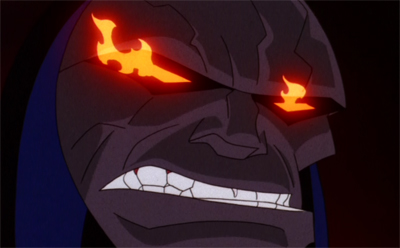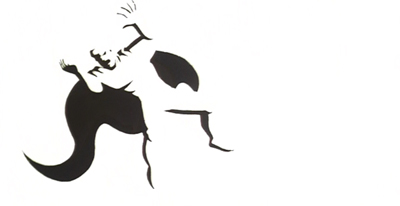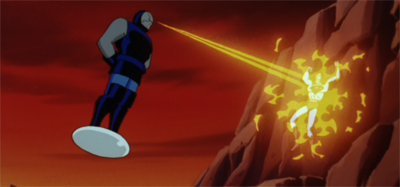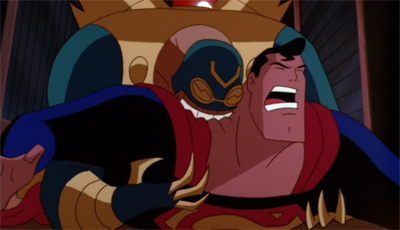This September marks the twentieth anniversary of Batman: The Animated Series, and the birth of the shared DC animated universe that would eventually expand to present one of the most comprehensive and thorough explorations of a comic book mythology in any medium. To celebrate, we’re going back into the past and looking at some classic episodes.
It seems fair enough to concede that Superman doesn’t really have the strongest selection of bad guys ever invented for a comic book character. You can definitely see that in the production of Superman: The Animated Series. While the writers did the best with the material at hand, you get a sense that they knew they didn’t have as many characters to play with as they did on Batman: The Animated Series. So they did two things to help compensate for this fact. The first thing was the decision to structure very clear character arcs for big bad guys like Luthor or Brainiac, where it becomes clear the audience can’t watch the series out of order. The second thing, and the one most relevant to this review, was the decision to incorporate Jack Kirby’s Fourth World mythos into the series.
To be fair, I think that Darkseid actually works quite well as an adversary for Superman. Since the end of Kirby’s Fourth World saga, the bad guy has appeared semi-frequently in stories like The Great Darkness Saga or Final Crisis, as something of a “very big bad” in the context of the DC universe as a whole. The villain is a force to be reckoned with, and I’d consider him to be one of Jack Kirby’s best villainous creations (only Galactus comes close, if he can be considered a villain), and perhaps the most significant contribution that Kirby made to DC as a company. However, despite the scale of the character and the threat he represents, I’ve always found that he plays best off Superman.
Perhaps, of course, that’s because Superman exists as this sort of archetypal hero, and so inherently makes a perfect foil for the archetypal villain, but I think there’s more than that. Superman was created as the champion of “Truth, Justice and the American Way.”Ignoring the blatant jingoism of that claim, it fairly accurately represents the character. The early stories saw Superman as a champion of the working class, fighting against the oppression of the corrupt system. Later on, he’d embody the virtues of liberty and freedom against the tyranny of Nazi Germany.
Jack Kirby wrote the New Gods of the Fourth World as the personifications of various concepts, drawn from a rich tapestry of mythology. As such, Darkseid is the literal embodiment of tyranny. You could argue that all superheroes are similar embodiments of metaphysical constructs, with Batman as the spirit of urban vengeance, a gargoyle for the modern age, or Spider-Man as the expression of the notion of the “little guy” capable of impossibly great feats. However, Superman is very much the quintessential superhero, the archetypal superhero. He’s a pop culture icon who is associated in the public consciousness with “truth and justice”, so he makes a perfect counterpart to Darkseid.
If one adheres the symbolism that Donner built into his Superman film, with the rather strong Superman-as-Christ metaphor, then Darkseid makes an effective Satan. He appears and disappears from Bruno Mannheim’s office in a bunch of red flames, for example. Indeed, Apokolips… Now!even features a scene on a mountain overlooking Metropolis where Darkseid tempts the hero.It lends the episode a rather grand mythological feeling, and it makes me wonder what Richard Donner would have done with Darkseid.
“I could easily destroy you now,” the villain taunts the Man of Steel, “and once you’re gone, the pathetic beings of this planet won’t have the will to resist me… the few who survive, that is. However, if you join me as my loyal vassal, I could guarantee a moderate amount of… restraint. Think of it Superman… the power you have now, its nothing compared to what I’m offering you.” In fact, a lot of that seems to foreshadow the series finale, Legacy, but it’s still very clear symbolism, something that establishes Darkseid as more than just another villain-of-the-week.
Apokolips… Now! marks a bit of a turning point in the DC animated universe. For one thing, the stakes seem much higher here. While Superman has confronted alien visitors before, there’s the sense of a hostile universe out there just waiting to reduce Earth to ashes. As he abandons his invasion, Darkseid dismisses the planet as an “insignificant speck in the universe”, and Apokolips… Now!is the first time that we really feel that, despite the visitors from the outside world and Superman’s trips to outer space.
“I didn’t not return you to Earth so you could engage in petty theft,” Darkseid warns Mannheim, as we get a sense of the villain’s ambitions. “Petty?” Mannheim responds. “We cleared over twenty million!” That is a lot of money, but it’s completely meaningless to the villain Darkseid, who would make a point of vaporising it before leaving. “I play for higher stakes,” he assures Mannheim, confirming that he’s not a character who seeks material gain. Rather, he’s driven by a bigger philosophical concept.
In a way, the introduction of Darkseid seems quite similar to that of Ra’s Al Ghul in Batman: The Animated Series. Both villains had a bit of build up before appearing, and both represent a bit of a “game-changer” when contrasted to the hero’s usual adversaries. Ra’s Al Ghul is a global threat, rather than one who threatens merely Gotham. Darkseid threatens all of creation, not just Earth. It’s also telling that both characters seemed to invigorate the writing staff. Appearing towards the end of both shows, both villains managed to wrack up an impressive number of appearances. Darkseid seemed to dominate the last season of Superman: The Animated Series, appearing in three two-part episodes.
For any other villain, that might seem like overkill, but Darkseid is a compelling enough character to justify it. In fact, Apokolips… Now! gets away with quite a lot that a lesser episode would struggle with, by virtue of its seemingly massive scale. The climax of the first episode features a mushroom cloud, and things build from there. It’s this increased scope that allows the story room to breath, featuring an exposition-laden monologue about the shared histories of Apokolips and New Genesis.
The widescreen sequence of animated storyboards with narration look absolutely stunning, but it’s a testament to the skill of the writing and direction overall that it never slows down the pace of the story. It is essentially a massive info-dump, but it doesn’t feel like it, possibly because the illustrations look absolutely breathtaking. It also feels in keeping with the epic mythological sweep of Kirby’s narrative, as if we are witnessing an oral history of an ancient and timeless conflict.
In keeping with that theme, I like how Superman is really more of a symbol in this episode. Sure, he does a lot of stuff. He prevents the fire from reaching the planet’s core, and he fends off herds of Parademons, but it seems like Superman’s primary value here is as a symbol. The episode opens with an InterGang attack on the Metropolis Police Department, as if to illustrate how far things have escalated. Batman’s arrival in Gotham prompted an escalation in the insanity of the city, but Superman’s arrival in Metropolis escalated the scale of the threats.
“Dan, these aren’t simple street punks,” Maggie advises Turpin after a brutal raid on police holding by the thugs armed with advanced alien technology. At this point, most police departments would acknowledge that they are hopelessly outgunned, and simply accept Superman as an essential part of their policing system – counting on the hero to do the heavy-lifting for them. While such an approach would make sense, it ignores the value of Superman as an aspirational figure. Superman doesn’t exist to lull the world into complacency, as hinted at in Mark Millar’s superb Red Son. He serves as an inspiration to better ourselves, to rise to the challenge.
So Dan Turpin serves as the perfect example of this, despite his scepticism about Superman. When Lois raises the issue of Superman taking on the gang, Turpin responds, “I’m saying we can’t always count on one guy to save our sorry butts.” Turpin isn’t stupid. He can see that the scale of the threat is more than his police can handle. He concedes as much to the Man of Steel, “You know, Superman, I play a pretty good game… but not in this league.”
And yet it’s Turpin who proves vital at key moments, despite being nothing more than just a man. It’s Turpin, not Superman, who takes down Steppenwolf. When Darkseid parades Superman through Metropolis, again treating the Man of Steel as a symbol rather than a character in his own right, it’s Turpin who stands up to the dictator in the only way he knows how. The episode is dedicated to Jack Kirby, and Turpin is very clearly a Kirby stand-in. Kirby was an artist who had a habit of drawing characters refusing to compromise with big bullies, imagining a world where symbols of virtue would protect the world from those who felt their might gave them authority.
Of course, there are consequences. What was quite nice about Darkseid as a character was that he very seldom “lost” completely, and that most of his defeats ended up affecting Superman almost as much. The death of Dan Turpin is a brutal moment, if only because it’s the first time we’ve seen something like this on a Bruce Timm show. It’s a stunningly petty act, one made with a minimum effort, as if Darkseid were doing nothing more strenuous than swatting a fly. It does an excellent job establishing the scale of Darkseid.
That said, the entirety of Apokolips… Now! seems surprisingly brutal for an animated episode. One wonders how all of it got past the Broadcast Standards. Despite the fact that death is kept (mostly) off-screen, there’s a lot of implied stuff. When Mannheim takes control of the nuclear station, we see the Parademons advancing menacingly on the staff. In the next scene, Mannheim assures Darkseid, “The island’s been evacuated, just like you ordered.”Because I’m sure Mannheim and the Parademons took the time to load all the staff into boats and ship them back to Metropolis.
Bruno Mannheim himself is pretty clearly dead, making it into a boat trying to clear the blast, only to get caught in a tidal wave and never to appear again. When you compare it the awkward steps that other episodes would make to ensure we knew that nobody was harmed, it seems especially brutal, as if the show has passed some sort of watershed, and things have just become a great deal more serious for our hero. The stakes have dramatically increased.
It really shouldn’t be a big deal, but I do like that the producers managed to sneak in a reference to Maggie Sawyer’s sexuality. It’s a shame that network television is so close-minded that such references have to be made under the radar, but it’s nice to see the portrayal of a sincere and affectionate homosexual relationship that isn’t a big deal. Maggie’s girlfriend is just there to be with her, and nobody seems to care. If only the real world worked that way.
Michael Ironside is perfectly cast as Darkseid, to the point where I really can’t imagine another actor in the role. Indeed, if Zack Snyder does find himself directing a movie featuring Darkseid, he’d do well to keep Ironside involved. The man’s voice just exudes a creepy inhuman authority, a very calm and restrained voice that masks a lot of sheer aggression. Ironside is one of the very best voices recruited by the incredibly talented Andrea Romano to work on these cartoons, and it works so well that I even hear Ironside’s voice when reading the comic books.
Apokolips… Now! is a stunning little episode, and a wonderful example of just how impressive the scales of Superman: The Animated Series could get. In a nice nod to the comics, I love how the animators set the second episode at twilight, with red skies providing an atmospheric and ominous backdrop to the excitement. It really is a fantastic illustration of how effective Superman: The Animated Series could be when it found its own voice.
Filed under: Television | Tagged: batman, batman animated series, Bruno Mannheim, crime, Dan, Dan Turpin, darkseid, dc animated universe, Earth, FourthWorld, JackKirby, Maggie Sawyer, Mannheim, metropolis, superman, Theft, Turpin |






























Leave a comment